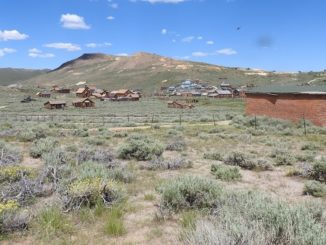
Kamala Harris,
Gage Skidmore – Licence CC BY-SA 1.0
Part way between Del Mar (Where the Surf Meets the Turf), Reno (The Biggest Little City in the World), and weird Portland, lies the San Francisco Bay area of Northern California. San Francisco itself is up a cul-de-sac, like a sunny Barrow-in-Furness or a counter-cultural Kingston upon Hull. Surrounded on three sides by the Pacific Ocean, the Golden Gate Straights and San Francisco Bay, a four-mile-long road bridge connects The City to blue-collar Oakland and its neighbour, the preppy university town of Berkeley. Three decades ago, a young gentleman and his resting soap star companion would break their rail journey there, on the seven hundred mile trip from high wage Southern California to low tax Nevada.
After alighting at Oakland’s 16th Street Station, with its magnificent but crumbling and underused vaulted station hall, they’d take the bus to Frisco. For the rest of her short life, she told of the cable cars, middle-aged hippies and painted lady houses. He still talks about the ‘no blood for oil’ pacifist riot. From working-class Oakland, the railroad passes into upper-middle-class Berkeley and then swings inland, east towards Nevada, via Sacramento the state capital of California. Another break of journey calls. She must visit the historic Old Sacramento riverfront, he has heard great things of the railroad museum.
Both want to ride the trams, not least to check that the streets really are named A Street, B Street, C Street, rather than Front Street, First Street, Second Street, Third Street. Both of us also wanted to visit the neoclassical 150-year-old state capitol building whose debating chambers lay beneath a decorated dome of gold rush miner-forty-niner gold leaf. Thirty years ago, in more relaxed times, a polite request would be met with a guided tour. One highlight being the State Treasurer’s Office which, at one time, held the entire wealth of the State of California. Some gold coins remained in a display case.
The assemblyman showing us around asked a couple of questions. Why are lines engraved around the coin’s edges? Even I knew that. It’s real gold. The coin is actually worth its face value. Damage to the decorated edge reveals any precious metal stolen. Why do cowboys bite a coin in old films? My companion knew. She’d auditioned for a Western. To make sure the middle is made of real gold and not cheapo, fake, no-good, God damned, brittle gold plate and lead.
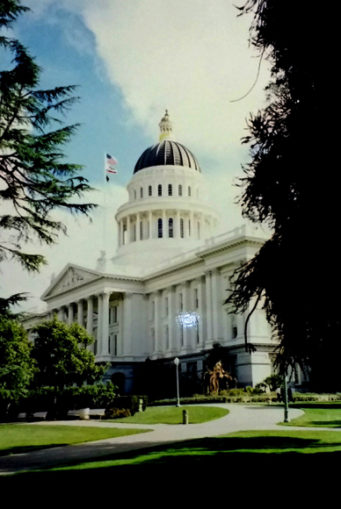
© Always Worth Saying, Going Postal 2020
In the unprecedented times in which we now live, may I pose more contemporary questions? How genuine is the daughter of Northern California politics, Kamala Harris? Of what mettle is she really made?
***
Kamala Iyer Harris was born on the 20th October 1964 at Kaiser Foundation Hospital in Oakland, California. The newly blessed parents were an Indian mother, Shyamala, who had recently been awarded a PhD in nutrition and endocrinology from the University of California at Berkeley. The father, Donald, was a brilliant student and teaching fellow, who was to become a Professor of Economics at the prestigious Stanford University. Born in Brown’s Town Jamaica in 1923, Donald Harris benefitted from a University College of the West Indies education, which awarded him a University of London Degree. Subsequently, a British Empire scholarship took him to Berkeley.
In an article published in the Jamaica Global, Donald traced his family tree. His grandfather married a Christiana ‘Miss Chrissy’ Brown. Her father was Hamilton Brown, her grandfather was also called Hamilton Brown. The Browns were an Irish Protestant family and well established plantation owners (after which Browns Town was named). At the abolition of slavery, the Browns had 1,120 slaves and were awarded £24,000 in compensation which would be the equivalent of £2.5 million in today’s money.
Shyamala, Donald and their first born lived comfortably enough in an apartment on Regent Street in Central Berkeley, only a stone’s throw away from the university where Donald and Shyamala had met, fallen in love and married. Those obsessed with such things will be pleased to hear that Kamala’s birth certificate was altered in the February after her birth, with her original given middle name being altered to ‘Devi’, which means goddess.
‘Iyer’ is a Chennai Brahmin name, no doubt originally nodding towards Shyamala’s family roots. Her father was P.V. Gopalan, a senior civil servant and diplomat. A high caste native of Bombay, it was he who paid for Shyamala’s tuition at Berkeley. PV’s siblings were a computer science PhD, an obstetrician and an information scientist (who worked for the government of Canada).
Kamala’s early childhood included trips to her parent’s native India and Jamaica, and to Southern Africa where PV Gopalan served at the Indian mission to Zambia. By now, the Harris’s Berkeley base was a duplex (Americanese for an upstairs/downstairs semi) on Bancroft Way, between Bonar and Browning Streets, still close to the university. Nowadays, similar properties are valued at about the $1,000,000 mark.
By the time Kamala was seven, Shyamala and Donald had divorced, Kamala had a younger sister called Maya and Kamala herself was being bussed to elementary school at Thousand Oaks, about a mile and three quarters away from her home. Columbus Elementary School (subsequently renamed after Rosa Parkes) was much nearer, but the policy at the time was to bus children from area to area in order to encourage racial integration. Therefor, Kamala attended a mainly white school.
These days, Harris has been immortalised in a mural at Thousands Oaks. She sits alongside Malala, Dolores Huerta (a trades unionist), Ruth Asawa (sculptor), Serena Williams and Anne Frank. Bussing in Alameda County ended in the 1990s. Schooling is now based upon neighbourhood rather than racial mixing. These days, there is only one black teacher at Thousand Oaks.
In her part memoir, part political manifesto, “The Truths We Hold”, Ms Harris describes a Waltonsesque childhood, too saccharine sweet, its recollection too carefully a constructed dog’s dinner of the Democrat’s various constituencies. It also contains too many mentions of ‘black.’
Passages include,
A close-knit neighbourhood of working families who were focused on doing a good job, paying the bills, and being there for one another. It was a community that was invested in its children, a place where people believed in the most basic tenet of the American dream: that if you work hard and do right by the world, your kids will be better off that you are.
Those working people including endocrinologist ‘uncle’ Howard who brought Kamala a pearl necklace back from a trip to Japan. As working folks do.
Harris makes much mention of coming from Oakland, when, in point of fact, she doesn’t. A mistake still present on her Senator’s biography. In her memoir, she says that she lived on the boundary between Oakland and Berkeley, whereas in reality she lived in Central Berkeley. As with Joe Biden’s exaggerated, and oft mentioned connection to Scranton, Oakland is more working class. Its liberalism is more earthy. Oaklander’s might occupy Wall Street, Berklians might talk about it over a $10 coffee at the Rainbow Sign.
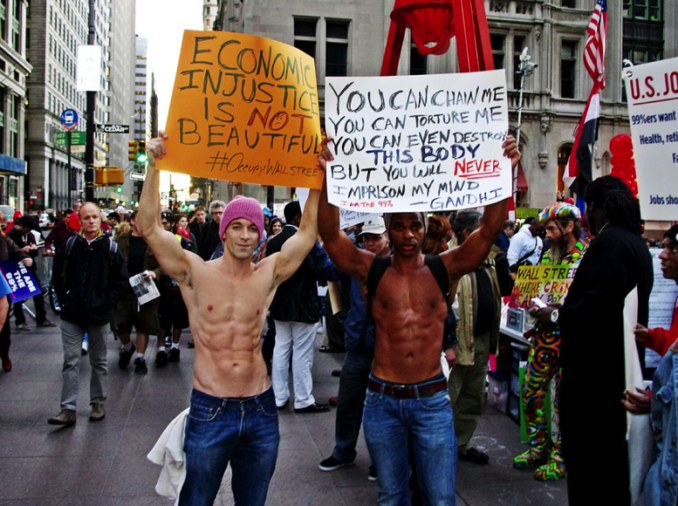
Day 40 Occupy Wall Street,
David Shankbone – Public Domain
In her memoir, Harris makes much of her time at the Rainbow Sign, giving herself an opportunity to keep on chanting ‘black’. At home, the family would play Aretha Franklin’s ‘To Be Young, to Be Gifted and Black’. Kamala and her sister graduated from that kind of thing to The Rainbow Sign, a community venue brainchild of Mary Ann Pollar (activist and impresario) and ten other black women. There, Harris, her mother and sister took part in a long list of left wing tropes of what Democrats think blacks do, from watching Nina Simone to eating peach cobbler.
In their history of the venue, Tessa Rissacher and Scott Saul are more sanguine. The Rainbow doesn’t appear in the history of East Bay black politics. Its own politics were difficult to pin down. The emphasis was on the arts, education and even self improvement through education which runs counter to to-day’s narrative of advancement through the demolition of ‘structural racism’. In any case, Kamala’s contact, however imagined, with progressive Bay Area and black politics came to an end aged twelve.
Then, the sisters and their mother moved to Montreal where Shyamala had been appointed to positions at McGill University and the Jewish Hospital. There, she specialised in cancer research. Kamala attended Notre Dame des Neiges school, briefly, to learn French, before moving to middle class Westmount High School. Her contemporaries speak highly of her, Dean Smith recalled her, “Perfect, always smiling, a nice person.”
“She carried herself in school much the way she did as a senator and presidential candidate,” says Paul Olioff, overcome by hindsight, “You saw a politician establishing herself.”
Former classmate Hugh Kwok remembers, “She was a very sweet, outgoing person, very popular, always positive.”
The LA times adds,
There [Westmount High] the young Harris co-founded a dance troupe, negotiated the straits of a diverse high school and brushed up for college at Howard University. She was intense and intellectual, neither pretentious nor precocious. Her classmates thought she was bound for big things.
In 1986, after five years at Westmount, Kamala graduated and duly went to Howard in Washington DC. Despite being bussed to a non-segregated elementary school, Harris had chosen to go to a black college to study Political Science and Economics. Howard was originally intended as a college for training black clergymen. Subsequently, it branched out into other areas, gaining as it did a reputation as a mecca for future black leaders. Usefully her mother had been a guest lecturer there and had friends on the faculty.
Tellingly, during her time there, the LA Times adds,
Campus politics were not always gentle. There were fights over where voting machines would be placed, and the hours they would be open.
Harris won a seat on the Liberal Arts Student Council during her freshman year. She interned on Capitol Hill as a mailroom clerk for California senator Alan Cranston. She chaired the economics society, led the debate team and joined the Alpha Kappa Alpha sorority. Her ambition was to go to a good law school, and go to a good law school she did, The University of California Hastings school. Puzzlingly, she was offered a place through their Legal Education Opportunity Program which made school accessible for ‘disadvantaged’ students.
On the Hasting’s website such places are said to be available to those, “who have experienced major life hurdles, such as educational disadvantage, economic hardship, or disability.” It is difficult to see which of those categories Harris might fall into. While at UC Hastings, she continued to be a high flyer, serving as president of the chapter of the Black Law Students Association and interning at the Alameda County District Attorney’s office.
At the DA’s office, she was offered a permanent position conditional on her successful graduation. Unfortunately, she failed her final exams but continued in a clerical capacity whilst studying for a successful re-sit the next year. Kamala Harris was finally called to the California Bar in 1990.
Upon leaving the DA’s office, Alameda County District Attorney Tom Orloff said of Harris that she had,
“a good courtroom presence, a high success rate. She is a genuinely good person and her social values will work well in San Francisco.”
In her memoir, Kamala skips over that time in Tom Orloff’s office in one brief sentence.
In 1998, after nine years in the Alameda county District Attorney’s Office, I was recruited across the bay to the San Francisco District Attorney’s Office.
A leap which allows for an important omission. During some of those nine years, Harris was the mistress of California Democrat royalty, Sacramento State Assembly Speaker Willie Brown. Brown has been instrumental in promoting her career. In March 1994, San Francisco Chronicle columnist Herb Caen called Kamala “the Speaker’s new steady.” In a symmetry that might impress designers of four mile long road bridges and compilers of long distance railway timetables, Harris was exactly half Brown’s age, 30 to 60. So what first attracted Kamala Harris to Democrat Kingmaker Brown?

Willie Brown,
Gage Skidmore – Licence CC BY-SA 2.0
In May 1994, Brown appointed Harris to a $97,088 a year position on the Unemployed Insurance Appeals Board. After six months she resigned, taking up a new job the very next week, also at the behest of Brown, at the California Medical Assistance Commission, two meetings a month, $99,000 per annum. More forthcoming than a Kamala Harris memoir, Willie Brown helpfully wrote an article on the matter in SFGate. He begins by saying that he has had many calls on the subject, which he hasn’t returned. He goes on to write,
“Yes, we dated. It was more than 20 years ago. Yes, I may have influenced her career by appointing her to two state commissions when I was Assembly speaker. And I certainly helped with her first race for district attorney in San Francisco. I have also helped the careers of House Speaker Nancy Pelosi,”
Latterly, USA Today reported that between 1994 and 1998, Harris was paid more than $400,000 owing to positions granted to her by Brown. Brown also gave her a BMW. Enquirers whose calls weren’t returned by Brown were the lucky ones. A larger than life character, his shameless, loud and endless self promotion includes claiming to be the,
“Renowned speaker of the California Assembly, and widely regarded as the most influential African American politician of the late twentieth century.”
He has served under every president from Lyndon Johnson to George W Bush and every Governor of California from Pat Brown to Arnold Schwarzenegger. Lack of space prevents a repetition of his full list of achievements, suffice it to say he “rebuilt the nation’s busiest transit system” and at the time of writing his resume (2019):
“Heads the Willie L. Brown Jr. Institute on Politics and Public Service, where he shares his knowledge and skills with a new generation of California leaders.”
Willie Lewis Brown Jr served in the California State Assembly between 1964 and 1995, being re-elected 16 times. For the final 15 years of his service, he was the Speaker of the Sacramento Assembly. Upon being replaced by a Republican, he was elected, and then re-elected, as mayor of San Francisco. His first act as mayor was to commission a $5,735 bust of himself to sit on a pedestal at the entrance to City Hall. His 60th birthday celebrations included an 8 foot high cake depicting a Mount Rushmore improved by the addition of his own likeness.
Famous for his $2,600 Brioni suit and $400 snap-brim fedora hat, Brown owned nine cars, including a Porsche and a Ferrari. When asked what he planned to do to for the less fortunate, he famously quipped, “Keep out of their way at Kmart.” After informing their readers of the gifted BMW, USA Today went on to shock them with the rather understated line, “Brown – whose career was dogged by corruption allegations.”
When Brown became mayor, Harris was unceremoniously dumped. She kept the $99,000 a year job, while Mrs Blanche Brown kept her husband and became the first lady of San Francisco. ‘Friends’ were heard to observe that Willie had graduated from a girl to a woman.
Kamala left her CMCA position in 1998, upon which her memoir miraculously begins again, having moved to the San Francisco District Attorney’s Office’s Career Criminal Unit and then on to Family Law. In 2003 she ran for District Attorney in San Francisco in a bruising election campaign in which her opponents employed language such as ‘bimbo’ and ‘sugar daddy’. ‘Spurned ex lover’ and ‘Willie Brown hack’ were also thrown into the mix.
To her credit, SFWeekly described her as
a well-regarded criminal and civil prosecutor with an enviable record on domestic violence and sexual abuse issues.
But the publication went on to point out that her opponents were well established names, whereas she was unknown outside of a local political, social and legal elite. Pretending to be from Oakland cut no ice here. SFWeekly printed that her upper middle class upbringing, law degree, and campaigning in the poorer areas of the city in that BMW, told against her.
However, Harris ran a slick campaign and was able to raise a lot of money, not least from that elite (novelist Danielle Steel was a contributor). An elite that Willie Brown had previously introduced her to. Brown himself made a personal campaign contribution of $500, the maximum allowed by law. Simultaneously, Brown’s old campaign manager, Phillip Muller, solicited more $500 dollar contributions by mailings which included Willie Brown’s personally signed recommendation. Muller funnelled the money into an expenditure committee called the ‘California Voter Project’ which bought radio time on behalf of Harris, as well as window signs and bumper stickers. California Voter Project also ran ads critical of Harris’s opponents.
Harris finished second in the primary election, 2.2% behind the incumbent, but being the sole anti-incumbent candidate in the runoff election, she won comfortably, 56 to 43.
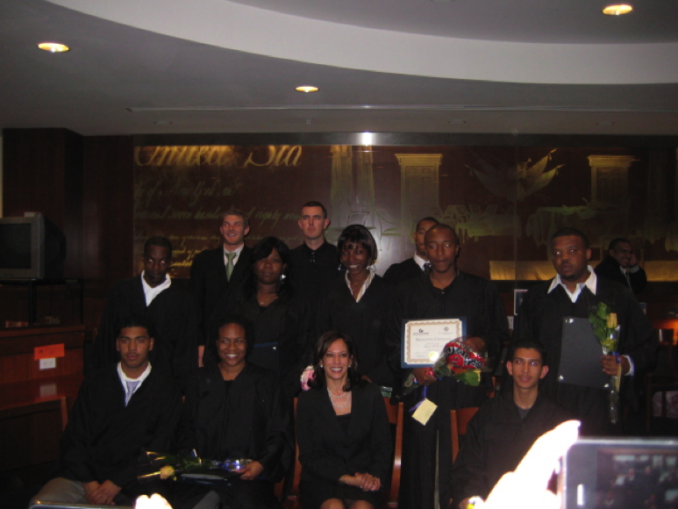
Back on track graduation,
Johny Cochran – Licence CC BY-SA 2.0
In 2007 she stood again, unopposed, and in 2010 stood for election as California Attorney General. A much closer contest followed. Interestingly, she won by only 0.7% of the vote. According to wiki, “after a protracted period of counting mail-in and provisional ballots,” her opponent conceded before all of the votes had been counted.
During her time as an elected official, Harris referred to herself as the ‘Top Cop’ and, perhaps contradictorily, as a ‘Progressive Prosecutor’. In order to continue to be elected, Harris had to talk tough and keep her office’s conviction rate high. This led to a number of over-enthusiastic but initially successful prosecutions, including that of Jamal Truelove, subsequently acquitted of murder and awarded $10 million dollars in compensation. There were others.
In a New York Times opinion piece, law professor Lara Bazelon notes that,
“In her career, Ms. Harris did not barter or trade to get the support of more conservative law-and-order types; she gave it all away,”
Allies of Harris have responded that she was progressive but had to work within the system at a time when ‘tough on crime’ was a cross-party consensus. They also point to initiatives such as her ‘Back on Track’ offender rehabilitation programme.
In 2016, Harris was elected to the US Senate in a straightforward landslide, having been well ahead in the polls for all of the campaign and having raised more than twice as much funding (nearly $10,000,000) as any of her competitors.
In 2018 she was appointed to the Senate Judiciary Committee. Her old law school, UC Hastings, describe her time there thus,
In the Senate, she became known for her trenchant cross-examination of witnesses while serving on the Judiciary Committee.
This is an exaggeration. Her questioning of Mark Zuckerberg and Christopher Wylie (of Cambridge Analytic) was reasonably well informed (compared with other, near brain dead, senators) and reasonably well prepared. However, she tended to grandstand and to pull the old lawyer’s trick of trying to play catch out by concentrating continually on one word or phrase. A tactic which impresses no one except other lawyers.
After announcing, in January 2019, that she would run for the Democratic Party’s presidential nomination, Harris started strongly, receiving big donations. However, the actual campaign didn’t go well. A brief TV debate blip in her favour, when she mentioned her ‘bussed’ childhood, in contrast to Biden’s then opposition, soon faded. Bloomberg characterised her decline thus,
Harris has struggled to gain traction in the polls after a brief high that sent her to second place in numerous polls after the first Democratic debate in June. Her campaign failed to catch on as she was unable to define herself ideologically and explain to voters what she stood for. A series of evolving slogans and campaign messages since the spring left voters unsure of what her convictions were.
After trying to repeat her attacks on Biden in subsequent debates, Harris took a nosedive in polls and never fully recovered. The final months of her campaign were characterized by regular stories of campaign turmoil and fundraising problems that left her pulling resources from key states like New Hampshire to stay afloat.
Miserably, her poll rating having dropped to 3.4%, Harris dropped out of the race as early as December 2019, with fifteen other Democrats still in the running. But salvation was at hand. Eight months later, old, white, male Joe Biden needed a young, non-white, female running mate. Of the twenty Democrat candidates who started the primaries, Harris was the only one who ticked the boxes. Likewise there’s only one ‘black’ senator (Harris) and no black state governors. Whilst having a second look at those boxes, strike out ‘young’ and replace it with ‘younger’. Harris is 56 and, away from the photoshoots and photoshop, looks every single day of it. She is the same age as Nixon when he became president. Older than Lyndon Johnson, Jimmy Carter and George W Bush when they were sworn in. She is older than Bill Clinton and Barack Obama, even after they’d served two terms.
***
Away from politics, in 2014 Kamala Harris married Doug Emhoff, another lawyer, previously a $1m a year entertainment litigator. He has recently left his law firm, in anticipation of being offered a position in a possible Biden administration. Emhoff has two grown up children from a previous marriage, to film producer Kerstin Emhoff. Emhoff has an interesting list of clients, smothered under a current media honeymoon but which, at some point, may be used as a stick to beat him with.

SF pride parade,
Eddie Hernandez- – Licence CC BY-SA 4.0
The younger Harris sister, Maya, was born in Illinois, where Donald Harris worked as an assistant professor, thus providing another kick in the teeth to Kamala Harris’s claimed childhood connection to Oakland. Maya had a daughter when still at high school, studied at the University of California at Berkeley and then went to Stanford Law School. The University where her father was a professor. After qualifying, she worked for law firm Jackson Tufts Cole & Black. She has enjoyed a career in law, academe, philanthropy, writing and, yes, politics. In 2016 she was lead policy advisor to Hillary Clinton’s presidential campaign. These days, Maya is part of Kamala’s campaign team.
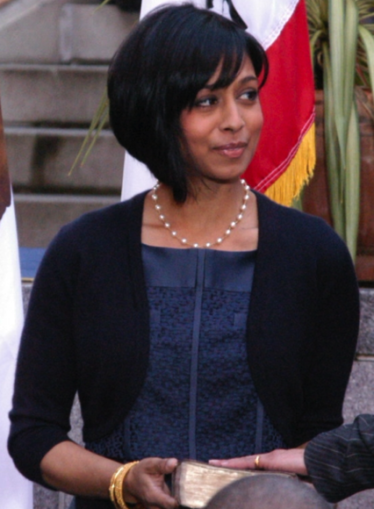
Maya Harris at Kamala Harris inauguration as Attorney General,
State of California – Copyright free
Maya is married to Tony West, another high flying lawyer who, amongst other things, is the chief legal officer for Uber. Maya’s daughter, Meena, now 36, is also a lawyer, a writer and, in the interests of equality of opportunity, aunty Kamala’s senior advisor on policy and communications.
***
In conclusion, Kamala Harris is a hard working, sharp elbowed, well qualified and experienced legal officer and provincial politician. She enjoys the connections and fund raising ability of an aged Grand Horizontal. As the the Democrats have weaponized race as a political strategy, Harris ticks enough of the facile narrative and optic boxes, but only by the skin of her teeth. The calculation is, that she is electable, nothing else matters. Her progressiveness is pragmatic, if not non-existent. She is part of a small town legal and political clan which threatens to hum like a manure heap. In a Biden administration, she would rely very heavily upon long-standing appointed swamp professionals. The edges are missing, the middle is fake. If there is a Biden administration and Joe doesn’t last the full term, Kamala Harris would likely become a kind of President Hillary Clinton, with more skirts, fewer trouser suits and a tan.
Acknowledgements
The Appeal
Bloomberg
Genii.com
Harris, Kamala, “The Truths We Hold.”
Jamaica Global
SFWeekly
The LA Times
The New York Times
Rissacher & Saul, “For the Love of People.”
UCHastings Website
The Willie L. Brown Jr. Institute on Politics and Public Service
Wiki
The Goodnight Vienna Audio file


